Effect of Milling Time and Reinforcement Volume Fraction on Microstructure and Mechanical Properties of SiCp-Reinforced AA2017 Composite Powder Produced by High-Energy Ball Milling
Abstract
1. Introduction
2. Materials and Methods
2.1. Raw Materials
2.2. Composites Powder Preparation
2.3. Composite Powder Characterization
3. Results and Discussion
3.1. Microstructural Characterization
3.2. Phase Analysis of the AA2017 + SiCp Composite Powders
3.3. Microhardness Measurement
4. Conclusions
Author Contributions
Funding
Institutional Review Board Statement
Informed Consent Statement
Data Availability Statement
Acknowledgments
Conflicts of Interest
References
- Prabhu, B.; Suryanarayana, C.; An, L.; Vaidyanathan, R. Synthesis and characterization of high volume fraction Al–Al2O3 nanocomposite powders by high-energy milling. Mater. Sci. Eng. 2006, 425, 192–200. [Google Scholar] [CrossRef]
- Ashwath, P.; Xavior, M.A. The Effect of Ball Milling and Reinforcement Percentage on Sintered Samples of Aluminium Alloy Metal Matrix Composites. Procedia Eng. 2014, 97, 1027–1032. [Google Scholar] [CrossRef]
- Wagih, A. Synthesis of Nanocrystalline Al2O3 Reinforced Al Nanocomposites by High-Energy Mechanical Alloying: Microstructural Evolution and Mechanical Properties. Trans. Indian Inst. Met. 2016, 69, 851–857. [Google Scholar] [CrossRef]
- Khdair, A.I.; Fathy, A. Enhanced strength and ductility of Al-SiC nanocomposites synthesized by accumulative roll bonding. J. Mater. Res. Technol. 2020, 9, 478–489. [Google Scholar] [CrossRef]
- Kamrani, S.; Penther, D.; Ghasemi, A.; Riedel, R.; Fleck, C. Microstructural characterization of Mg-SiC nanocomposite synthesized by high energy ball milling. Adv. Powder Technol. 2018, 29, 1742–1748. [Google Scholar] [CrossRef]
- Nagaral, M.; Auradi, V.; Parashivamurthy, K.I.; Shivananda, B.K.; Kori, S.A. Dry Sliding Wear Behaviour of Aluminium 6061-SiC-Graphite Particulates Reinforced Hybrid Composites. IOP Conf. Ser. Mater. Sci. Eng. 2018, 310, 12156. [Google Scholar] [CrossRef]
- Sudha, G.T.; Stalin, B.; Ravichandran, M.; Balasubramanian, M. Mechanical Properties, Characterization and Wear Behavior of Powder Metallurgy Composites—A Review. Mater. Today Proc. 2020, 22, 2582–2596. [Google Scholar] [CrossRef]
- Parveen, A.; Chauhan, N.R.; Suhaib, M. Influence of Process Parameters and Reinforcements on Aluminum Hybrid Composites Developed by Powder Metallurgy Process. Phys. Met. Metallogr. 2021, 122, 1007–1013. [Google Scholar] [CrossRef]
- Rahimian, M.; Parvin, N.; Ehsani, N. The effect of production parameters on microstructure and wear resistance of powder metallurgy Al–Al2O3 composite. Mater. Des. 2011, 32, 1031–1038. [Google Scholar] [CrossRef]
- Sharifi, H.; Borujeni, H.R.; Nasresfahani, M.R. The influence of volume fraction of SiC particles on the properties of Al/SiCp nanocomposites produced by powder metallurgy with high energy ball milling. Russ. J. Non-Ferr. Met. 2016, 57, 728–733. [Google Scholar] [CrossRef]
- Chen, S.; Tao, Z.; Liu, Z.; Wang, Z.; Liao, D.; Tang, H.; Zhang, F. Preparation and characterization of nanodiamond-reinforced 6061 aluminum matrix composites via a slurry process and high-energy ball milling. Diam. Relat. Mater. 2023, 135, 109829. [Google Scholar] [CrossRef]
- Ashrafi, N.; Azmah Hanim, M.A.; Sarraf, M.; Sulaiman, S.; Hong, T.S. Microstructural, Tribology and Corrosion Properties of Optimized Fe3O4-SiC Reinforced Aluminum Matrix Hybrid Nano Filler Composite Fabricated through Powder Metallurgy Method. Materials 2020, 13, 4090. [Google Scholar] [CrossRef] [PubMed]
- Sattari, S.; Jahani, M.; Atrian, A. Effect of Volume Fraction of Reinforcement and Milling Time on Physical and Mechanical Properties of Al7075–SiC Composites Fabricated by Powder Metallurgy Method. Powder Metall. Met. Ceram. 2017, 56, 283–292. [Google Scholar] [CrossRef]
- Aliyu, I.; Saheb, N.; Hassan, S.; Al-Aqeeli, N. Microstructure and Properties of Spark Plasma Sintered Aluminum Containing 1 wt.% SiC Nanoparticles. Metals 2015, 5, 70–83. [Google Scholar] [CrossRef]
- Suryanarayana, C. Mechanical alloying and milling. Prog. Mater. Sci. 2001, 46, 1–184. [Google Scholar] [CrossRef]
- Liu, J.; Cao, G.; Zhu, X.; Zhao, K.; An, L. Optimization of the microstructure and mechanical properties of heterogeneous Al-Al2O3 nanocomposites. Mater. Today Commun. 2020, 25, 101199. [Google Scholar] [CrossRef]
- Canakci, A.; Varol, T.; Ertok, S. The effect of mechanical alloying on Al2O3 distribution and properties of Al2O3 particle reinforced Al-MMCs. Sci. Eng. Compos. Mater. 2012, 19, 227–235. [Google Scholar] [CrossRef]
- Ponhan, K.; Tassenberg, K.; Weston, D.; Nicholls, K.G.; Thornton, R. Effect of SiC nanoparticle content and milling time on the microstructural characteristics and properties of Mg-SiC nanocomposites synthesized with powder metallurgy incorporating high-energy ball milling. Ceram. Int. 2020, 46, 26956–26969. [Google Scholar] [CrossRef]
- Wagner, S.; Siebeck, S.; Hockauf, M.; Nestler, D.; Podlesak, H.; Wielage, B.; Wagner, M.F.-X. Effect of SiC-Reinforcement and Equal-Channel Angular Pressing on Microstructure and Mechanical Properties of AA2017. Adv. Eng. Mater. 2012, 14, 388–393. [Google Scholar] [CrossRef]
- Trautmann, M.; Ahmad, H.; Wagner, G. Influencing the Size and Shape of High-Energy Ball Milled Particle Reinforced Aluminum Alloy Powder. Materials 2022, 15, 3022. [Google Scholar] [CrossRef]
- Ostovan, F.; Matori, K.A.; Toozandehjani, M.; Oskoueian, A.; Yusoff, H.M.; Yunus, R.; Ariff, A.H.M. Microstructural evaluation of ball-milled nano Al2O3 particulate-reinforced aluminum matrix composite powders. Int. J. Mater. Res. 2015, 106, 636–640. [Google Scholar] [CrossRef]
- Ghasemi, A.; Penther, D.; Kamrani, S. Microstructure and nanoindentation analysis of Mg-SiC nanocomposite powders synthesized by mechanical milling. Mater. Charact. 2018, 142, 137–143. [Google Scholar] [CrossRef]
- Poole, J.M.; Fischer, J.J. Recent Developments in Mechanical Alloying. Mater. Technol. 1994, 9, 21–25. [Google Scholar] [CrossRef][Green Version]
- Nestler, D.; Siebeck, S.; Podlesak, H.; Wagner, S.; Hockauf, M.; Wielage, B. Powder Metallurgy of Particle-Reinforced Aluminium Matrix Composites (AMC) by Means of High-Energy Ball Milling. In Integrated Systems, Design and Technology 2010; Springer Science and Business Media LLC: Berlin/Heidelberg, Germany, 2011; pp. 93–107. ISBN 978-3-642-17383-7. [Google Scholar]
- Hu, Y.; Wu, T.; Guo, Y.; Wang, W.; Song, M.; Qian, L.; Zhao, H.; Wang, M. Effects of T6 Treatment, Tensile Temperature, and Mass Fraction of SiC on the Mechanical Properties of SiCp/6061Al Composites. Materials 2019, 12, 1602. [Google Scholar] [CrossRef] [PubMed]
- Salem, M.A.; El-Batanony, I.G.; Ghanem, M.; Abd ElAal, M.I. Effect of the Matrix and Reinforcement Sizes on the Microstructure, the Physical and Mechanical Properties of Al-SiC Composites. J. Eng. Mater. Technol. 2017, 139, 011007. [Google Scholar] [CrossRef]
- Salur, E.; Acarer, M.; Şavkliyildiz, İ. Improving mechanical properties of nano-sized TiC particle reinforced AA7075 Al alloy composites produced by ball milling and hot pressing. Mater. Today Commun. 2021, 27, 102202. [Google Scholar] [CrossRef]
- Prashanth, M.; Karunanithi, R.; Sivasankaran, S.; Villarejo, L.P. Grain refinement and mechanical properties enhancement on inclusion of Al2O3 in AA 7017 alloy synthesized by mechanical alloying (MA) and hot pressing (HP). Mater. Today Commun. 2022, 33, 104735. [Google Scholar] [CrossRef]
- Bathula, S.; Anandani, R.C.; Dhar, A.; Srivastava, A.K. Microstructural features and mechanical properties of Al 5083/SiCp metal matrix nanocomposites produced by high energy ball milling and spark plasma sintering. Mater. Sci. Eng. A 2012, 545, 97–102. [Google Scholar] [CrossRef]
- Nassar, A.E.; Nassar, E.E. Numerical Predictions of the Mechanical Properties of A356-SiC Composites Fabricated by Powder Metallurgy. Trans. FAMENA 2016, 40, 83–94. [Google Scholar] [CrossRef]
- Parvin, N.; Assadifard, R.; Safarzadeh, P.; Sheibani, S.; Marashi, P. Preparation and mechanical properties of SiC-reinforced Al6061 composite by mechanical alloying. Mater. Sci. Eng. A 2008, 492, 134–140. [Google Scholar] [CrossRef]
- Hockauf, M.; Meyer, L.W.; Krüger, L. Combining Equal-Channel Angular Extrusion (ECAE) and Heat Treatment for Achieving High Strength and Moderate Ductility in an Al-Cu Alloy. MSF 2008, 584–586, 685–690. [Google Scholar] [CrossRef]
- Abu-Warda, N.; Utrilla, M.V.; Escalera, M.D.; Otero, E.; López, M.D. The effect of TiB2 content on the properties of AA6005/TiB2 nanocomposites fabricated by mechanical alloying method. Powder Technol. 2018, 328, 235–244. [Google Scholar] [CrossRef]
- Feijoo, I.; Pena, G.; Cabeza, M.; Cristóbal, M.J.; Rey, P. MWCNT-Reinforced AA7075 Composites: Effect of Reinforcement Percentage on Mechanical Properties. Metals 2021, 11, 969. [Google Scholar] [CrossRef]
- Broitman, E. Indentation Hardness Measurements at Macro-, Micro-, and Nanoscale: A Critical Overview. Tribol. Lett. 2017, 65, 23. [Google Scholar] [CrossRef]
- Williamson, G.; Hall, W. X-ray line broadening from filed aluminium and wolfram. Acta Metall. 1953, 1, 22–31. [Google Scholar] [CrossRef]
- Gemeda, B.A.; Sinha, D.K.; Singh, G.K.; Alghtani, A.H.; Tirth, V.; Algahtani, A.; Mengesha, G.A.; Ahmed, G.M.S.; Hossain, N. Effect of Sintering Temperatures, Reinforcement Size on Mechanical Properties and Fortification Mechanisms on the Particle Size Distribution of B4C, SiC and ZrO2 in Titanium Metal Matrix Composites. Materials 2022, 15, 5525. [Google Scholar] [CrossRef]
- Khakbiz, M.; Akhlaghi, F. Synthesis and structural characterization of Al–B4C nano-composite powders by mechanical alloying. J. Alloys Compd. 2009, 479, 334–341. [Google Scholar] [CrossRef]
- Toozandehjani, M.; Matori, K.A.; Ostovan, F.; Abdul Aziz, S.; Mamat, M.S. Effect of Milling Time on the Microstructure, Physical and Mechanical Properties of Al-Al2O3 Nanocomposite Synthesized by Ball Milling and Powder Metallurgy. Materials 2017, 10, 1232. [Google Scholar] [CrossRef]
- Ozdemir, I.; Ahrens, S.; Mücklich, S.; Wielage, B. Nanocrystalline Al–Al2O3p and SiCp composites produced by high-energy ball milling. J. Mater. Process. Technol. 2008, 205, 111–118. [Google Scholar] [CrossRef]
- Safari, J.; Akbari, G.H.; Shahbazkhan, A.; Delshad Chermahini, M. Microstructural and mechanical properties of Al–Mg/Al2O3 nanocomposite prepared by mechanical alloying. J. Alloys Compd. 2011, 509, 9419–9424. [Google Scholar] [CrossRef]
- Hesabi, Z.R.; Simchi, A.; Reihani, S.S. Structural evolution during mechanical milling of nanometric and micrometric Al2O3 reinforced Al matrix composites. Mater. Sci. Eng. A 2006, 428, 159–168. [Google Scholar] [CrossRef]
- Guo, H.; Zhao, Y.; Xu, S.; Li, J.; Liu, N.; Zhang, Y.; Zhang, Z. Influence of high B4C contents on structural evolution of Al-B4C nanocomposite powders produced by high energy ball milling. Ceram. Int. 2019, 45, 5436–5447. [Google Scholar] [CrossRef]
- Fathy, A.; Wagih, A.; Abd El-Hamid, M.; Hassan, A.A. Effect of Mechanical Milling on the Morphologyand Structural Evaluation of Al-Al2O3 Nanocomposite Powders. Int. J. Eng. 2014, 27, 625–635. [Google Scholar] [CrossRef]
- Wagih, A. Mechanical properties of Al–Mg/Al2O3 nanocomposite powder produced by mechanical alloying. Adv. Powder Technol. 2015, 26, 253–258. [Google Scholar] [CrossRef]
- Varol, T.; Canakci, A. Synthesis and characterization of nanocrystalline Al2024–B4C composite powders by mechanical alloying. Philos. Mag. Lett. 2013, 93, 339–345. [Google Scholar] [CrossRef]
- Kwon, H.; Saarna, M.; Yoon, S.; Weidenkaff, A.; Leparoux, M. Effect of milling time on dual-nanoparticulate-reinforced aluminum alloy matrix composite materials. Mater. Sci. Eng. A 2014, 590, 338–345. [Google Scholar] [CrossRef]
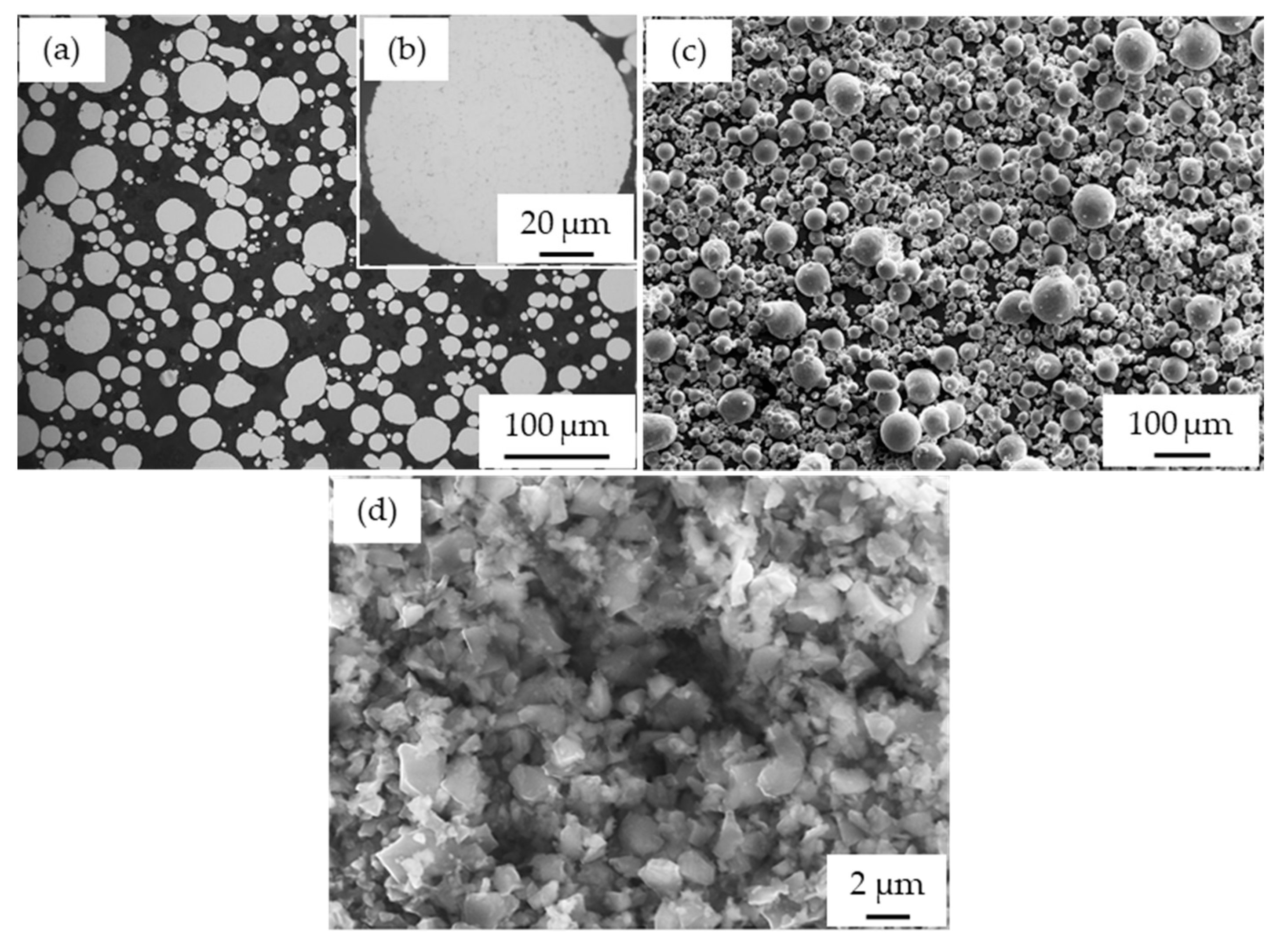
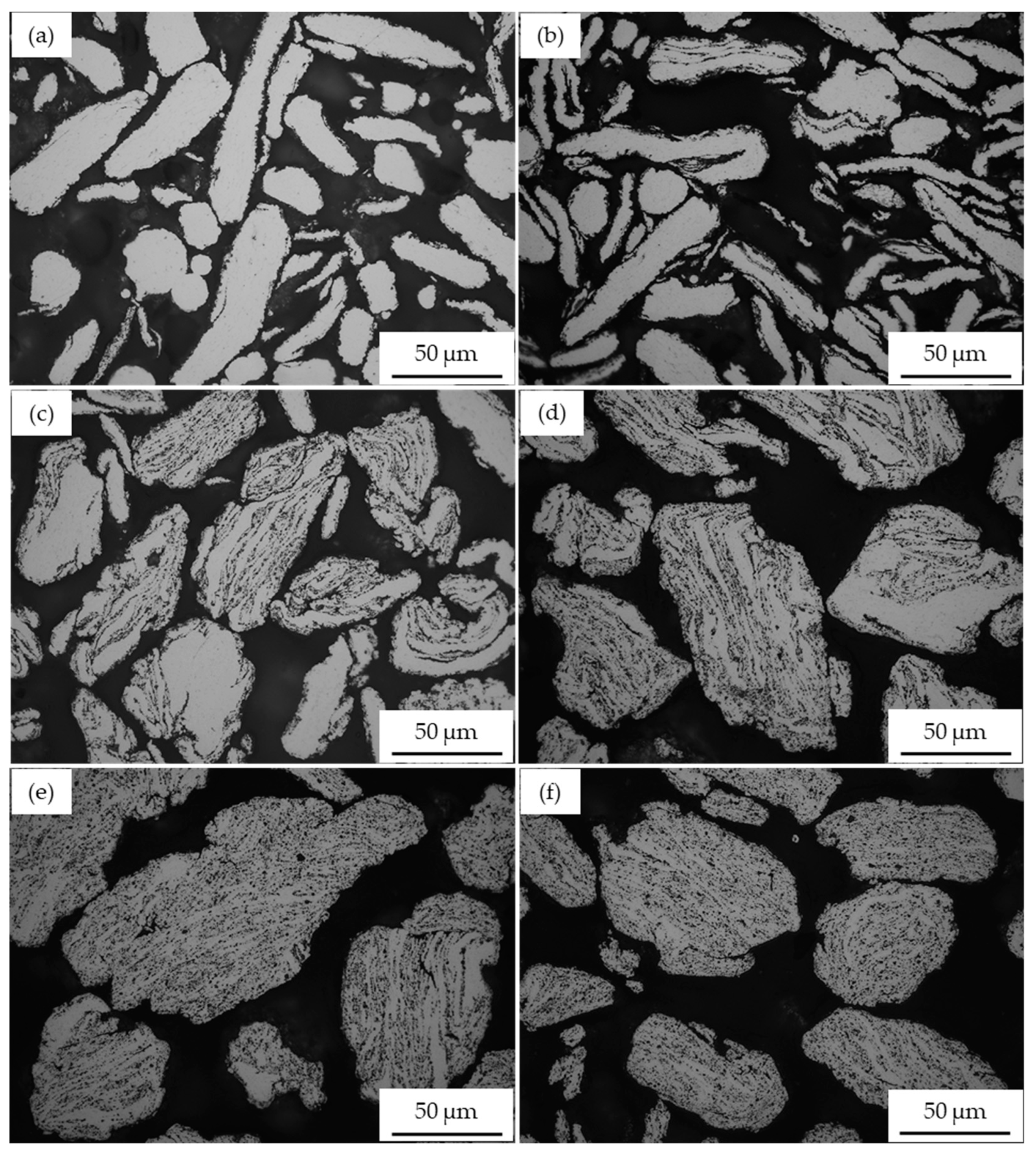

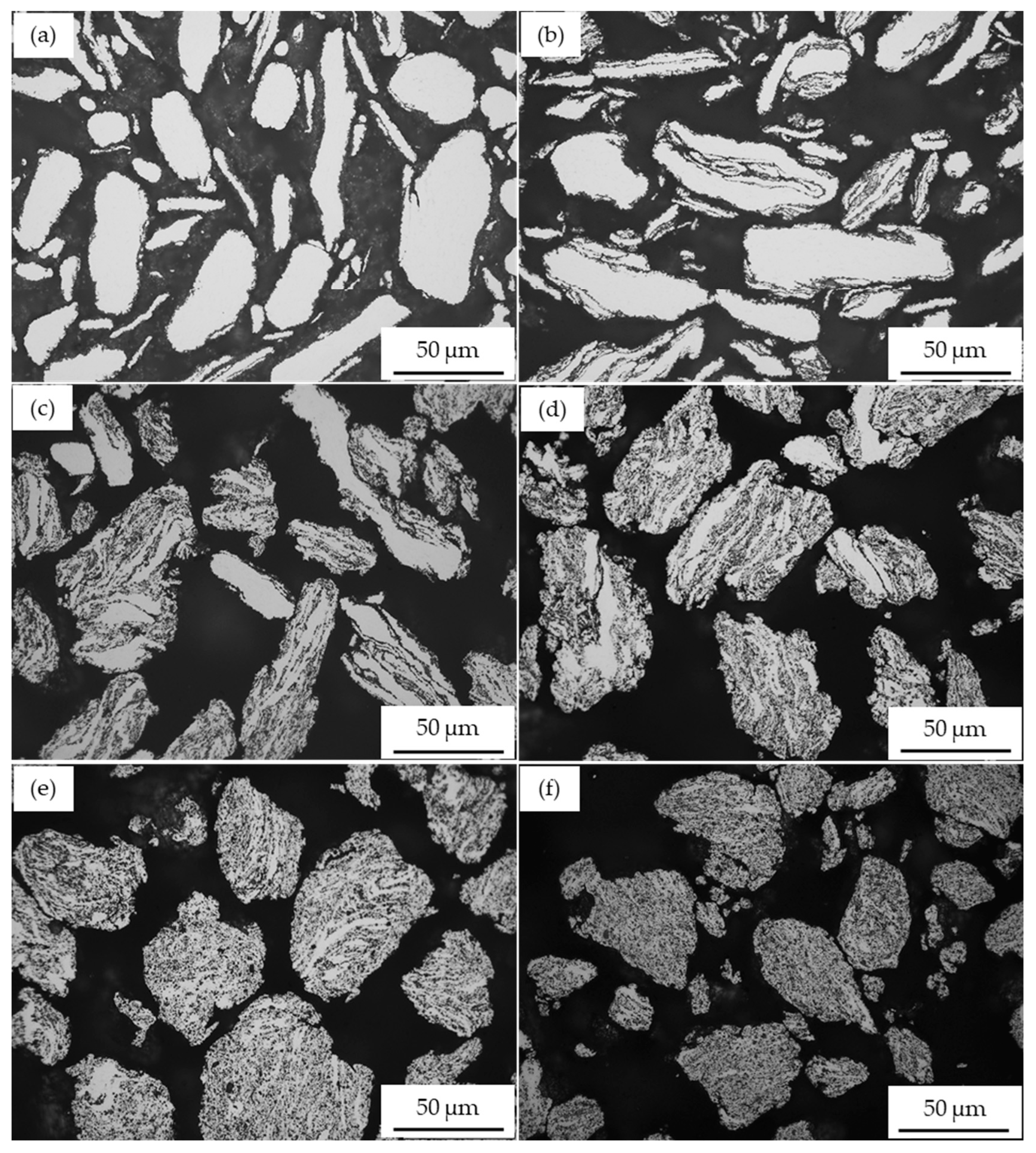
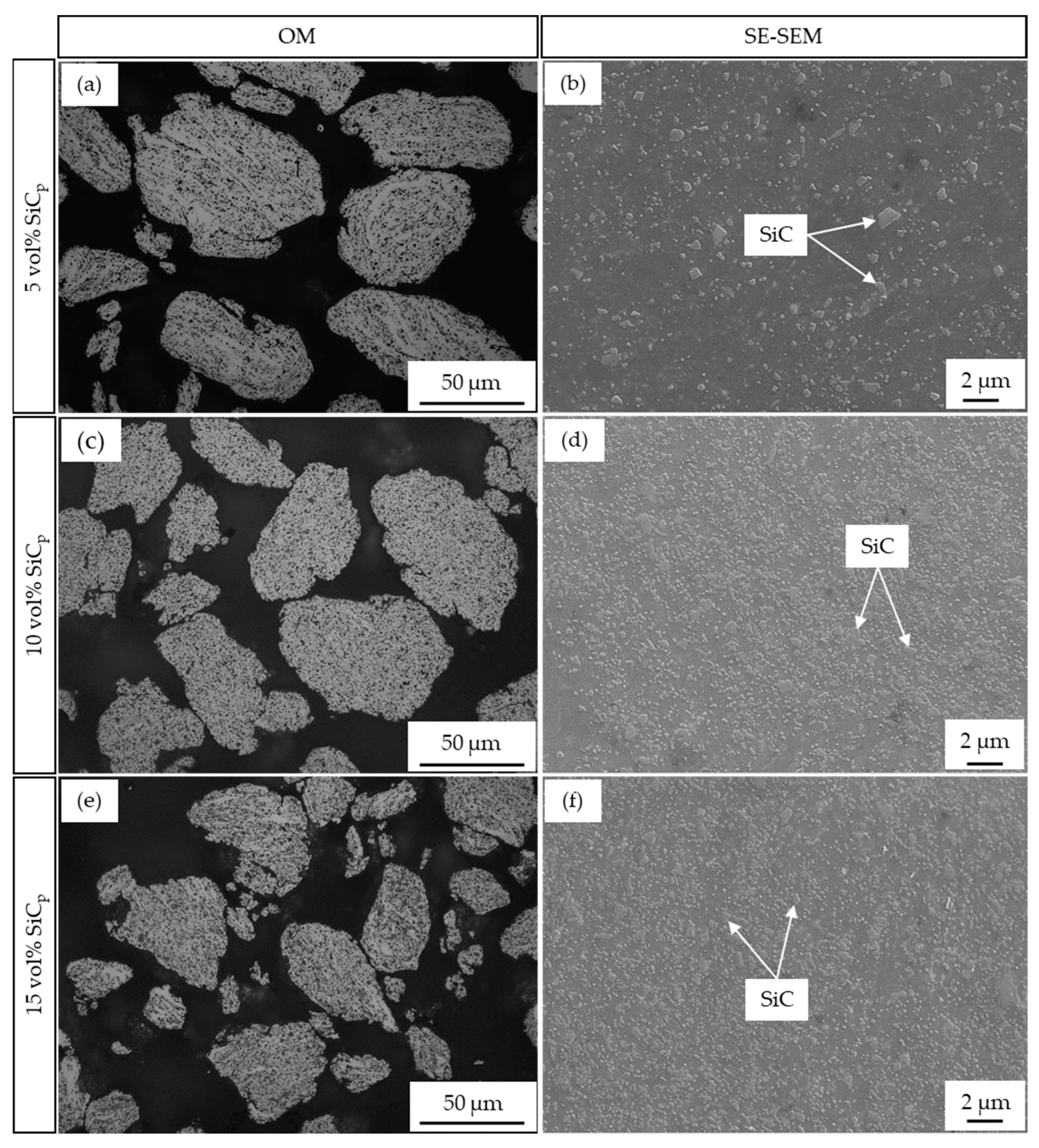

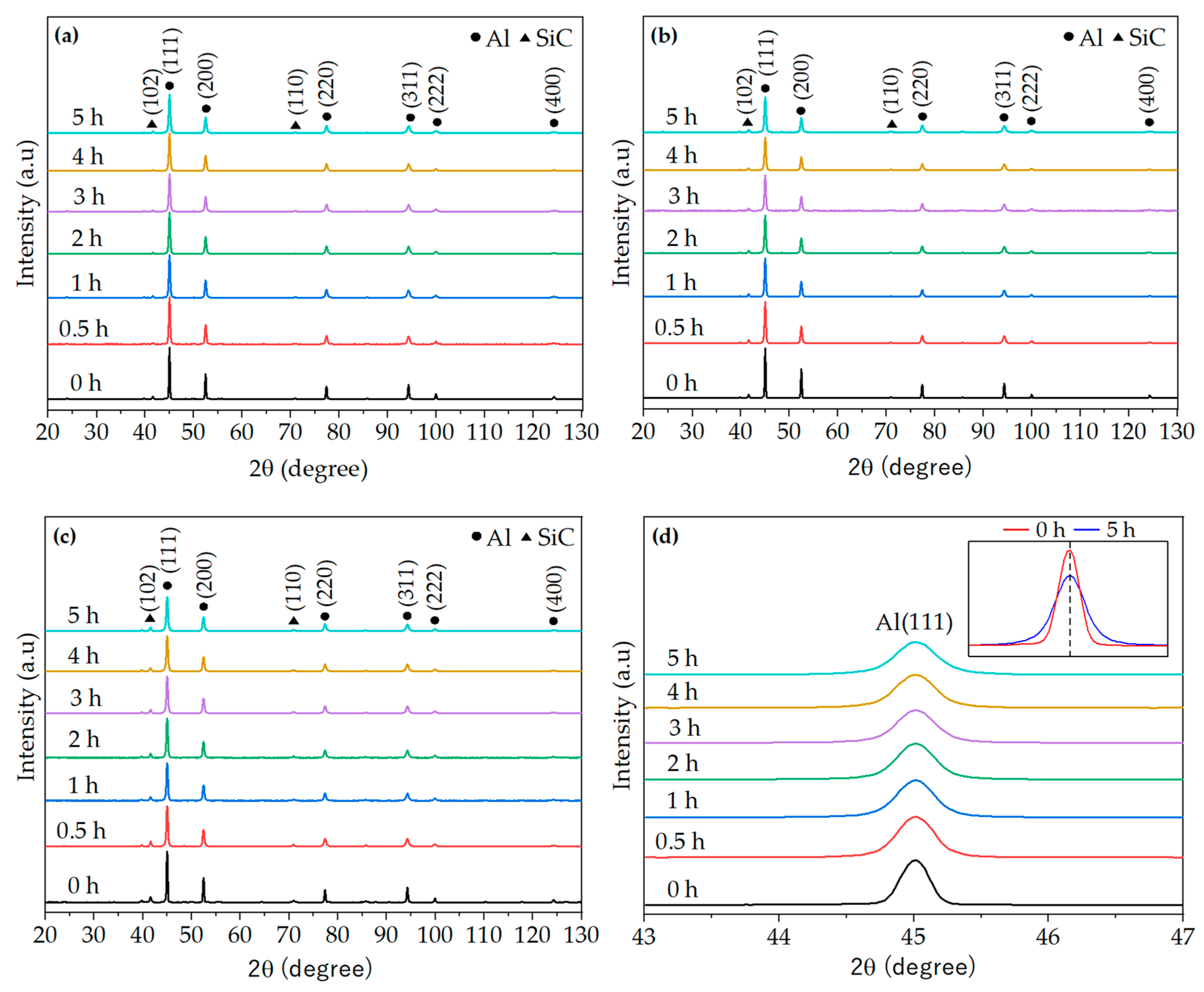
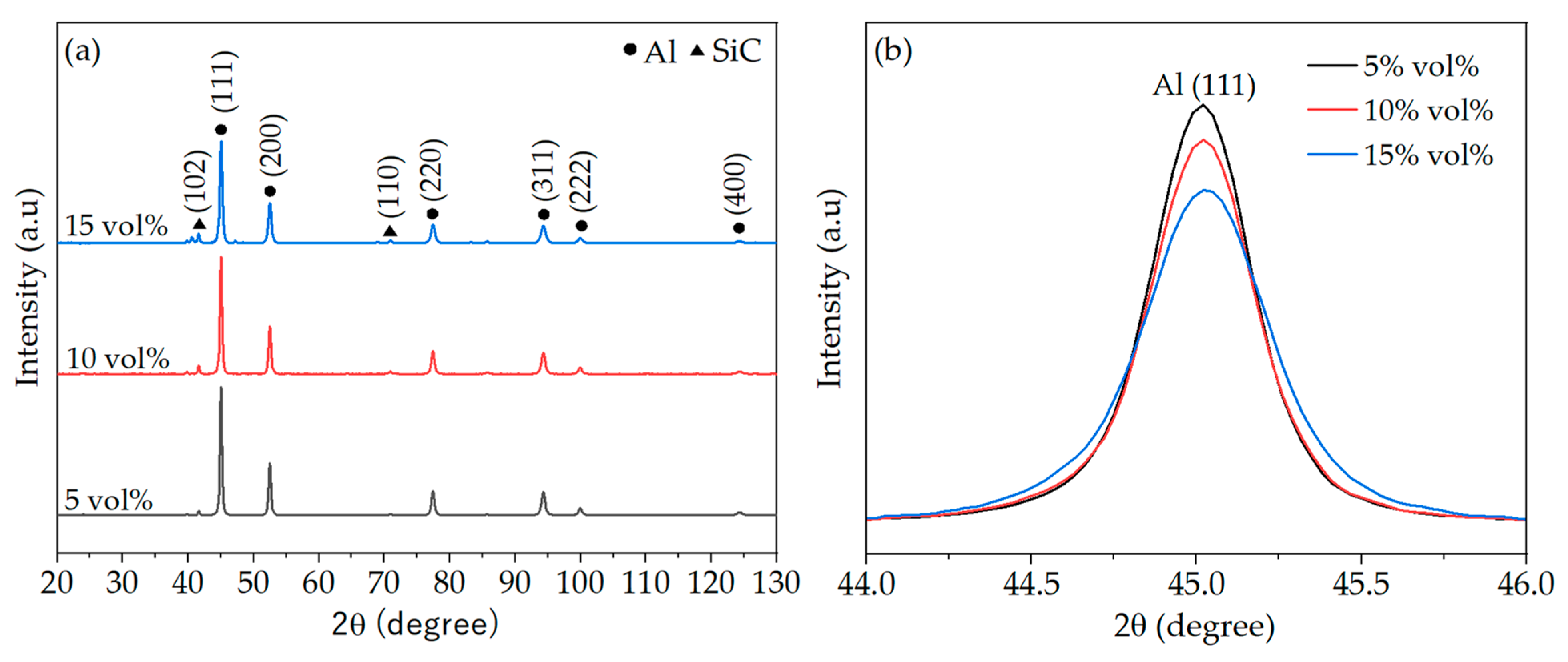


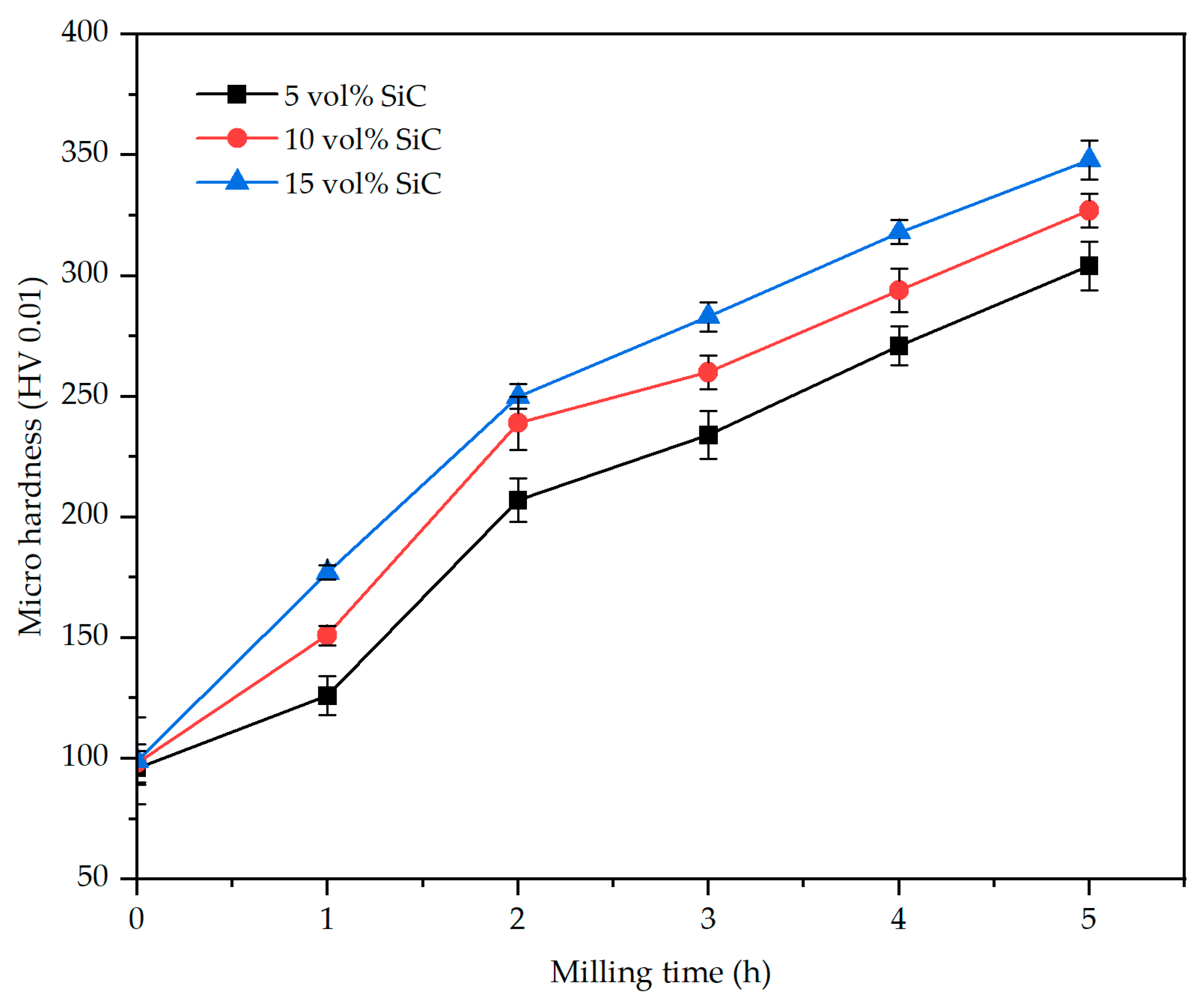
| Chem. Element | Cu | Mn | Mg | Fe | Si | Al |
| Content (wt%) | 3.94 | 0.59 | 0.77 | 0.2 | 0.1 | Balanced |
| Milling Parameters | Value |
|---|---|
| Milling time | 5 h |
| Milling Rotor speed | 400 and 600 rpm (cyclic) |
| Weight of powder mixture | 800 g |
| Weight of steel balls | 8 kg |
| Milling ball diameter | Ø 4.76 mm |
| Stearic acid (PCA) amount | 0.5 wt% |
Disclaimer/Publisher’s Note: The statements, opinions and data contained in all publications are solely those of the individual author(s) and contributor(s) and not of MDPI and/or the editor(s). MDPI and/or the editor(s) disclaim responsibility for any injury to people or property resulting from any ideas, methods, instructions or products referred to in the content. |
© 2024 by the authors. Licensee MDPI, Basel, Switzerland. This article is an open access article distributed under the terms and conditions of the Creative Commons Attribution (CC BY) license (https://creativecommons.org/licenses/by/4.0/).
Share and Cite
Gasha, S.B.; Trautmann, M.; Wagner, G. Effect of Milling Time and Reinforcement Volume Fraction on Microstructure and Mechanical Properties of SiCp-Reinforced AA2017 Composite Powder Produced by High-Energy Ball Milling. Materials 2024, 17, 435. https://doi.org/10.3390/ma17020435
Gasha SB, Trautmann M, Wagner G. Effect of Milling Time and Reinforcement Volume Fraction on Microstructure and Mechanical Properties of SiCp-Reinforced AA2017 Composite Powder Produced by High-Energy Ball Milling. Materials. 2024; 17(2):435. https://doi.org/10.3390/ma17020435
Chicago/Turabian StyleGasha, Shimelis Bihon, Maik Trautmann, and Guntram Wagner. 2024. "Effect of Milling Time and Reinforcement Volume Fraction on Microstructure and Mechanical Properties of SiCp-Reinforced AA2017 Composite Powder Produced by High-Energy Ball Milling" Materials 17, no. 2: 435. https://doi.org/10.3390/ma17020435
APA StyleGasha, S. B., Trautmann, M., & Wagner, G. (2024). Effect of Milling Time and Reinforcement Volume Fraction on Microstructure and Mechanical Properties of SiCp-Reinforced AA2017 Composite Powder Produced by High-Energy Ball Milling. Materials, 17(2), 435. https://doi.org/10.3390/ma17020435






